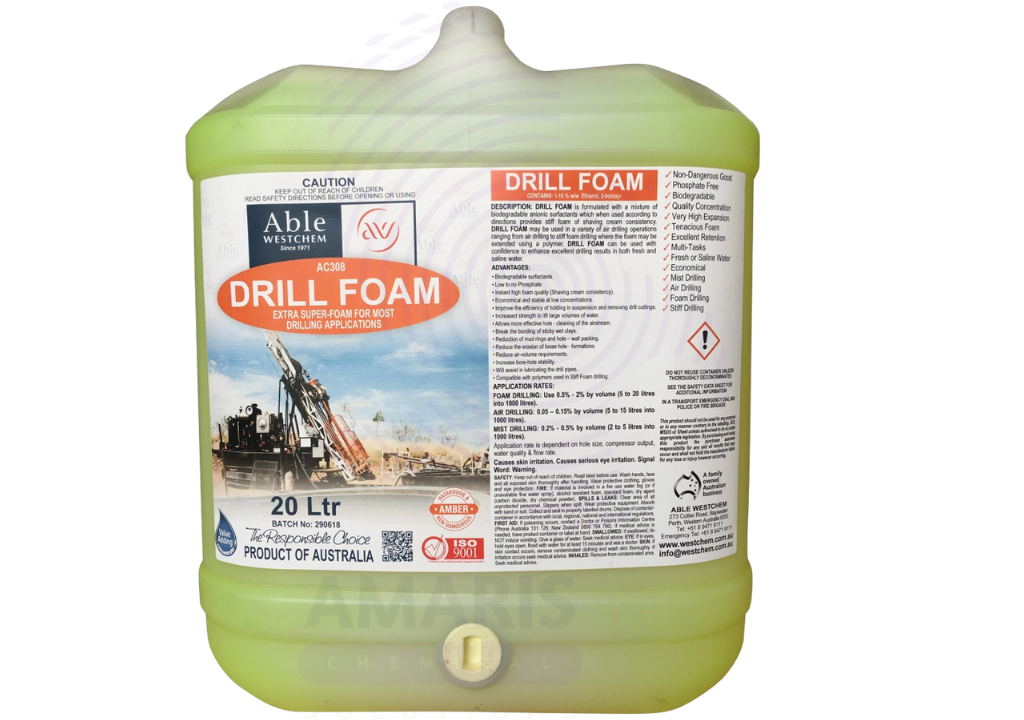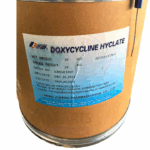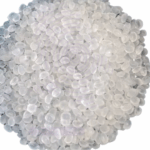Drilling Foam
Whatsapp Order
Drilling Foam is a specialized foam-based drilling fluid additive designed to improve the efficiency and safety of drilling operations in oil, gas, and mineral exploration. It is formulated to generate stable, low-density foam that enhances cuttings transport, reduces formation damage, and improves wellbore stability. Drilling Foam reduces the hydrostatic pressure exerted on formations, allowing drilling in weak or fractured zones with minimal risk of collapse or fluid loss. It is typically composed of surfactants, foaming agents, and stabilizers compatible with water-based drilling fluids.
Category: Frothers
Tags: Drilling Fluid Additive, Drilling Foam, Oil and Gas Industry, Oilfield Chemical, Well Drilling
Description
Table of Contents
Toggle
Drilling Foam Uses
Primary Uses
- Oil & Gas Drilling
- Used as a drilling fluid additive to create foam-based mud systems that provide low-density and high-foaming properties.
- Enhances cuttings removal from the wellbore by improving the carrying capacity of drilling fluids.
- Reduces formation damage by minimizing fluid invasion in sensitive or fractured formations.
- Provides excellent lubricity and reduces torque and drag in directional and horizontal drilling.
- Improves wellbore stability in unstable or weak geological formations.
- Mineral Exploration Drilling
- Applied in water-based drilling systems for mineral and mining exploration to maintain borehole integrity.
- Enhances penetration rates by reducing fluid density and improving debris transport.
- Environmental Applications
- Used in environmentally sensitive drilling projects due to its lower toxicity and reduced environmental impact compared to oil-based muds.
- Supports reduced water consumption by stabilizing foam and lowering fluid volumes needed.
Secondary Uses
- Well Servicing & Workover Operations
- Utilized to improve hole cleaning during well maintenance and re-entry operations.
- Helps reduce differential sticking and formation damage during workovers.
- Geotechnical Drilling
- Used in soil sampling and foundation drilling to maintain borehole stability in soft soils.
- Firefighting Training & Testing
- Occasionally used in firefighting foam applications for training purposes due to its foaming properties (special formulations).
KEY PRODUCT FEATURES
1. Basic Identification Attributes
- Chemical Name: Mixture of surfactants and foam stabilizers
- Common/Trade Name: Drilling Foam
- CAS Number: Not applicable (mixture)
- HS Code: 3402.90.00 (surfactants and foam agents)
- Molecular Formula: Variable, depending on formulation
- Synonyms:
- Foam drilling fluid additive
- Drilling foam agent
- Foam-based drilling mud enhancer
2. Physical & Chemical Properties
- Physical State: Liquid concentrate or powder that forms foam upon mixing
- Color & Odor: Typically pale yellow to amber; mild surfactant odor
- pH: Typically 7–9 in working solutions
- Solubility: Soluble in water, forms stable foam
- Foam Stability: High foam half-life under downhole conditions
- Density: Low-density foam reduces fluid weight significantly
3. Safety & Hazard Attributes
- Hazard Class (GHS): Generally non-hazardous but may cause skin and eye irritation
- Toxicity: Low to moderate; avoid ingestion and prolonged skin contact
- Exposure Limits: No specific limits, use PPE to minimize exposure
4. Storage & Handling Attributes
- Storage Conditions: Store in a cool, dry place away from direct sunlight and freezing temperatures
- Container Type: Plastic drums, totes, or sealed containers
- Shelf Life: 12–24 months depending on formulation and storage
- Handling Precautions: Avoid inhalation of aerosols; use PPE when handling concentrated forms
5. Regulatory & Compliance Attributes
- Complies with environmental regulations for use in water-based drilling fluids
- May require specific local permits or documentation for offshore use
- Non-toxic formulations available for environmentally sensitive areas
6. Environmental & Health Impact
- Biodegradability: Many formulations are biodegradable and low environmental impact
- Ecotoxicity: Generally low; formulations designed to minimize aquatic toxicity
- Bioaccumulation: Not expected
- Carcinogenicity/Mutagenicity: Not classified as carcinogenic or mutagenic
SAFETY HANDLING PRECAUTIONS
Safety Handling Precautions
PPE Required:
- Gloves (nitrile or latex)
- Safety goggles
- Protective clothing
- Respiratory protection if aerosolized
Handling Guidelines:
- Avoid inhalation of mist or aerosols
- Prevent skin and eye contact
- Use in well-ventilated areas
- Follow all safety data sheet (SDS) instructions for specific formulations
Storage Measures:
- Keep containers tightly closed
- Store away from heat, sparks, and incompatible chemicals
- Avoid freezing and prolonged exposure to sunlight
Hygiene Practices:
- Wash hands after handling
- Avoid eating, drinking, or smoking in work areas
- Clean equipment regularly to prevent buildup
First Aid Measures
- Inhalation: Move to fresh air; seek medical attention if respiratory irritation persists
- Skin Contact: Wash with soap and water; seek medical attention if irritation develops
- Eye Contact: Rinse immediately with plenty of water for at least 15 minutes; consult physician if irritation persists
- Ingestion: Rinse mouth; do not induce vomiting; seek medical advice
Firefighting Measures
- Fire Hazards: Generally non-flammable; may decompose releasing irritating fumes when heated
- Extinguishing Media: Water spray, foam, dry chemical, or carbon dioxide
- Special Precautions: Use self-contained breathing apparatus in confined spaces
- Decomposition Products: Carbon oxides, nitrogen oxides, and other potentially toxic fumes


 Preservatives(food)
Preservatives(food) Flavor Enhancers
Flavor Enhancers Acidulants
Acidulants Sweeteners
Sweeteners Antioxidants
Antioxidants Colorants(food)
Colorants(food) Nutraceutical Ingredients (food)
Nutraceutical Ingredients (food) Nutrient Supplements
Nutrient Supplements Emulsifiers
Emulsifiers
 Collectors
Collectors Dust Suppressants
Dust Suppressants Explosives and Blasting Agents
Explosives and Blasting Agents Flocculants and Coagulants
Flocculants and Coagulants Frothers
Frothers Leaching Agents
Leaching Agents pH Modifiers
pH Modifiers Precious Metal Extraction Agents
Precious Metal Extraction Agents
 Antioxidants(plastic)
Antioxidants(plastic) Colorants (Pigments, Dyes)
Colorants (Pigments, Dyes) Fillers and Reinforcements
Fillers and Reinforcements Flame Retardants
Flame Retardants Monomers
Monomers Plasticizers
Plasticizers Polymerization Initiators
Polymerization Initiators Stabilizers (UV, Heat)
Stabilizers (UV, Heat)
 Antifoaming Agents
Antifoaming Agents Chelating Agents
Chelating Agents Coagulants and Flocculants
Coagulants and Flocculants Corrosion Inhibitors
Corrosion Inhibitors Disinfectants and Biocides
Disinfectants and Biocides Oxidizing Agents
Oxidizing Agents pH Adjusters
pH Adjusters Scale Inhibitors( water)
Scale Inhibitors( water)
 Antioxidants(cosmetic)
Antioxidants(cosmetic) Emollients
Emollients Fragrances and Essential Oils
Fragrances and Essential Oils Humectants
Humectants Preservatives
Preservatives Surfactants(cosmetic)
Surfactants(cosmetic) Thickeners
Thickeners UV Filters
UV Filters
 Fertilizers
Fertilizers Soil Conditioners
Soil Conditioners Plant Growth Regulators
Plant Growth Regulators Animal Feed Additives
Animal Feed Additives Biostimulants
Biostimulants Pesticides (Herbicides, Insecticides, Fungicides)
Pesticides (Herbicides, Insecticides, Fungicides)
 Active Pharmaceutical Ingredients (APIs)
Active Pharmaceutical Ingredients (APIs) Excipients
Excipients Solvents(pharmaceutical)
Solvents(pharmaceutical) Antibiotics
Antibiotics Antiseptics and Disinfectants
Antiseptics and Disinfectants Vaccine Adjuvants
Vaccine Adjuvants Nutraceutical Ingredients (pharmaceutical)
Nutraceutical Ingredients (pharmaceutical) Analgesics & Antipyretics
Analgesics & Antipyretics
 Analytical Reagents
Analytical Reagents Solvents(lab)
Solvents(lab) Chromatography Chemicals
Chromatography Chemicals Spectroscopy Reagents
Spectroscopy Reagents microbiology-and-cell-culture-reagents
microbiology-and-cell-culture-reagents Molecular Biology Reagents
Molecular Biology Reagents Biochemical Reagents
Biochemical Reagents Inorganic and Organic Standards
Inorganic and Organic Standards Laboratory Safety Chemicals
Laboratory Safety Chemicals Specialty Laboratory Chemicals(Special Laboratory Equipment)
Specialty Laboratory Chemicals(Special Laboratory Equipment)
 Demulsifiers
Demulsifiers Hydraulic Fracturing Fluids
Hydraulic Fracturing Fluids Scale Inhibitors(oil)
Scale Inhibitors(oil) Surfactants(oil)
Surfactants(oil) Drilling Fluids
Drilling Fluids
 Dyes and Pigments
Dyes and Pigments Bleaching Agents
Bleaching Agents Softening Agents
Softening Agents Finishing Agents
Finishing Agents Antistatic Agents
Antistatic Agents
 Admixtures
Admixtures Waterproofing Agents
Waterproofing Agents Sealants and Adhesives
Sealants and Adhesives Curing Compounds
Curing Compounds Concrete Repair Chemicals
Concrete Repair Chemicals Anti-Corrosion Coatings
Anti-Corrosion Coatings
 Surfactants(cleaning)
Surfactants(cleaning) Builders
Builders Enzymes
Enzymes Solvents (Cleaning)
Solvents (Cleaning) Fragrances
Fragrances
 Electronic Chemicals
Electronic Chemicals Catalysts
Catalysts Lubricants
Lubricants Photographic Chemicals
Photographic Chemicals Refrigerants
Refrigerants Automotive chemicals
Automotive chemicals Pyrotechnic Chemicals
Pyrotechnic Chemicals
 Biodegradable Surfactants
Biodegradable Surfactants Bio-based Solvents
Bio-based Solvents Renewable Polymers
Renewable Polymers Carbon Capture Chemicals
Carbon Capture Chemicals Wastewater Treatment Chemicals
Wastewater Treatment Chemicals
 Pigments
Pigments Solvents(paint)
Solvents(paint) Specialty Coatings
Specialty Coatings Binders/Resins
Binders/Resins Additives
Additives Driers
Driers Anti-Corrosion Agents
Anti-Corrosion Agents Functional Coatings
Functional Coatings Application-Specific Coatings
Application-Specific Coatings
 Fresh Herbs
Fresh Herbs Ground Spices
Ground Spices Whole Spices
Whole Spices Spice Blends
Spice Blends Dried Herbs
Dried Herbs
 Leavening Agents
Leavening Agents Dough Conditioners
Dough Conditioners Flour Treatments
Flour Treatments Fat Replacers
Fat Replacers Decoratives
Decoratives Preservatives(baking)
Preservatives(baking)
 Plasticizers & Softeners
Plasticizers & Softeners Reinforcing Agents
Reinforcing Agents Adhesion Promoters
Adhesion Promoters Vulcanizing Agents
Vulcanizing Agents Antidegradants
Antidegradants Blowing Agents
Blowing Agents Fillers & Extenders
Fillers & Extenders Accelerators & Retarders
Accelerators & Retarders


















